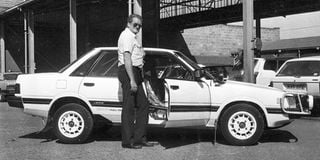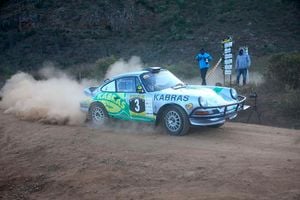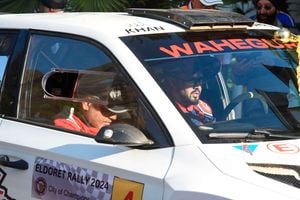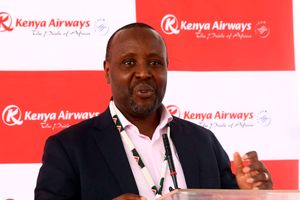
Jim Heather-Hayes poses with his Subaru during the 1989 Marlboro Safari Rally.
The Jim Heather-Hayes Memorial (JHHM) Rift 1000 Rally was held in Nanyuki last month with over 50 drivers participating.
From December 13 to 15 drivers endured the dust and rough conditions similar to the Safari Rally as they honoured one of the most accomplished rally driver, aviator, manager and mechanic in Kenyan motorsports, Jim Heather-Hayes.
The name lives on immortalised by the classical events that are proving popular. The 2025 East African Classic Safari Rally is due in December.
Friends of Heather-Hayes, who passed on in 2023, aged 75, congregated in Nanyuki and invited 52 drivers for the second Jim Heather Hayes Memorial Rift 1000 Rally that was won by Baldev Chager and Ravi Soni in a Porsche 911.
Heather-Hayes’s friends in the motorsport organised the Nanyuki classic event and confess they were surprised by the huge response, locally and abroad.
The entries were impressive considering that that the Kenya National Rally Championship (KNRC) received paltry dozen in their events last season.
Last season’s WRC Safari Rally y attracted 44 entries. The JHHM rally even had a 77-year-old driver, Mike Kirkland, one of the most successful Safari Rally drivers still alive after Mike Doughty and Ian Duncan.
There were other veterans as well, many of them retired with over 40 years of experience.
On the lower scale was Hamza Anwar, 25, a versatile driver who was last year named as one of the most improved drivers in the world in the Junior World Rally Championship (JWRC).
One of the main organisers was Frank Tundo, 75 who volunteered to design the route and take care of primary organisation on conditions that he would be allowed to take part in competition.
The rally also brought together semi-retired drivers who are all previous national champions -- Baldev Chager, Ian Duncan, Azar Anwar and Carl Tundo.
Other drivers like Eric Bengi also joined the nostalgia trip.
To say Heather-Hayes was a rally driver is an understatement. He was very fast but unfortunately was never given full factory team support consistently because he was more productive as a mechanic and chase car driver for these teams.
But he did compete in a few Safari rallies, his best results in 1990 when he finished sixth overall in a Subaru Legacy navigated by Anton Levitan.
He sometimes benefited by acquiring works cars left behind to for individuals or local franchises like Toyota Kenya and Associated Vehicles Assemblers (AVA) Mombasa, the company which assembled complete knocked down kits imported to Kenya.
AVA also had a competition department that once built a standard Peugeot 504 pick up to the FIA Group B super cars specifications which the federation homologated to compete in the 1983 Marlboro Safari Rally, driven by Johnny Hellier navigated by John Hope.
They finished eighth overall. The car has been restored and is owned by a local enthusiast.
AVA and the generation of Heather-Hayes are a testament of how Kenya developed in the car market and products development 40 years ago as well as how franchises used motorsports to promote new or existing models.
Toyota Kenya (now Cfao Motors Kenya) fielded and managed Toyota Team Kenya (TTK) in the local championship while AVA too had AVA-TTK which also built Ian Duncan a Toyota Corolla saloon for competition.
Heather-Hayes finest hour was in the 1987 Kenya National Rally Championship (KNRC) when eh took on favourite Duncan while driving an AVA Toyota Celica Twin cam Turbo car, a similar model Bjorn Walgergaard had driven to victory in the 1986 Safari.
Duncan also competed in works Toyota Celica. The monthly Autonews magazine published one of the most memorable race reports on Heather-Hayes in the Coca Cola International Rally, a round of the Kenyan championship, which summed up his superlative driving skills in a flowing captivating, report. It read:
“Big Jim Heather-Hayes caused a few hearts to flutter in the Coke International Rally with a blockbuster drive from the back of the field to within a few seconds of the leaders.
“But his remarkable effort ended in mix-ups and misfires, and the keenly anticipated face-off between the TTK Celica Turbo and the mechanically AVA-TTK Celica of Ian never materialised.”
Heather-Hayes was by then entering only selected races and won the Autocross National Championship in a BMW. He had also established himself as a seasoned works teams chase-car pilot.
Autonews wrote on:
“How would he fare against today’s pacesetters if given an outing in the all-conquering Toyota Celica Twincam Turbo?
“In his favour were nearly two decades of high level racing and rallying experience and the fact he’s done more miles in super powerful works cars than Duncan.
“Against Hayes were a shortage of match practise compared to Duncan and other top seeded driver Johnny Hellier who was driving a factory Ford Cosworth.
He was also seeded in position 28 and needed to plough through the dust of slower cars ahead under blinding dust and was lying second at the end of the first leg.”
All Kenya rally buffs waited with bated breath to discover how much faster Duncan would go if put under pressure.
But it all went off when Heather-Hayes overshot the control point at the end of the first competitive second of the second leg and incurred a five minutes penalty.
The real excitement evaporated after Heather-Hayes Celica turbo wastage pipe came loose and the turbo pressure dropped dramatically before the gear box shredded. But he had made a statement.
He was fast, very fast. This caught the attention of the Subaru team which enlisted the services of European professionals and locals in the 1989 Safari when it unleashed the Subaru Legacy RS Turbo Group A in the Safari with a star-studded field led by a former world champion Markku Alen of Finland.
Heather-Hayes was fielded in a less powerful Subaru RX Turbo and finished ninth. He improved to sixth in 1990 navigated by Anton Levitan in a Subaru Legacy.
He started appearing in less competitions, preferring to assist other drivers through his mechanical skills including Marco Brighetti in the mid 1990s.
Heather-Hayes passed on two years ago after the end of the East African Mini Classic in Eldoret, a death that shocked the rallying fraternity to the core as he had spent days in the company of friends before returning to his base in Tsavo.
Heather-Hayes, like most drivers of his generation, grew up around cars and was greatly influenced by his parents who were also pioneers of the Safari Rally.
His father also called Jim Heather-Hayes, raced in the very first Safari Rally in 1953, in a Morris Minor.
But it was in the 1980s when Heather-Hayes, the son, popular called “Big Jim” , emerged as an accomplished Chase Car driver for the factory teams.
Chase car drivers were as fast as the competing drivers and acted as first responders. There were capable of carrying out repairs in case of mechanical breakdowns.
They would sweep the road or follow competing cars closely behind and in cases of last resort, they would remove parts from their cars to assist stricken drivers.
Several people posted their memories of Heather-Hayes on the Jim Heather-Hayes Memorial (JHHM) Rift 100 Rally Facebook page
“The Second memory was when he saved my nephew Imran Khan’s life at Classic Rally, he was swept away by the river and almost drowned when Jim jumped in the river and pushed him into the bank and saved his life, that can never be forgotten ever by the Khan family, ” said Ayub Khan.
Unforgettable.









